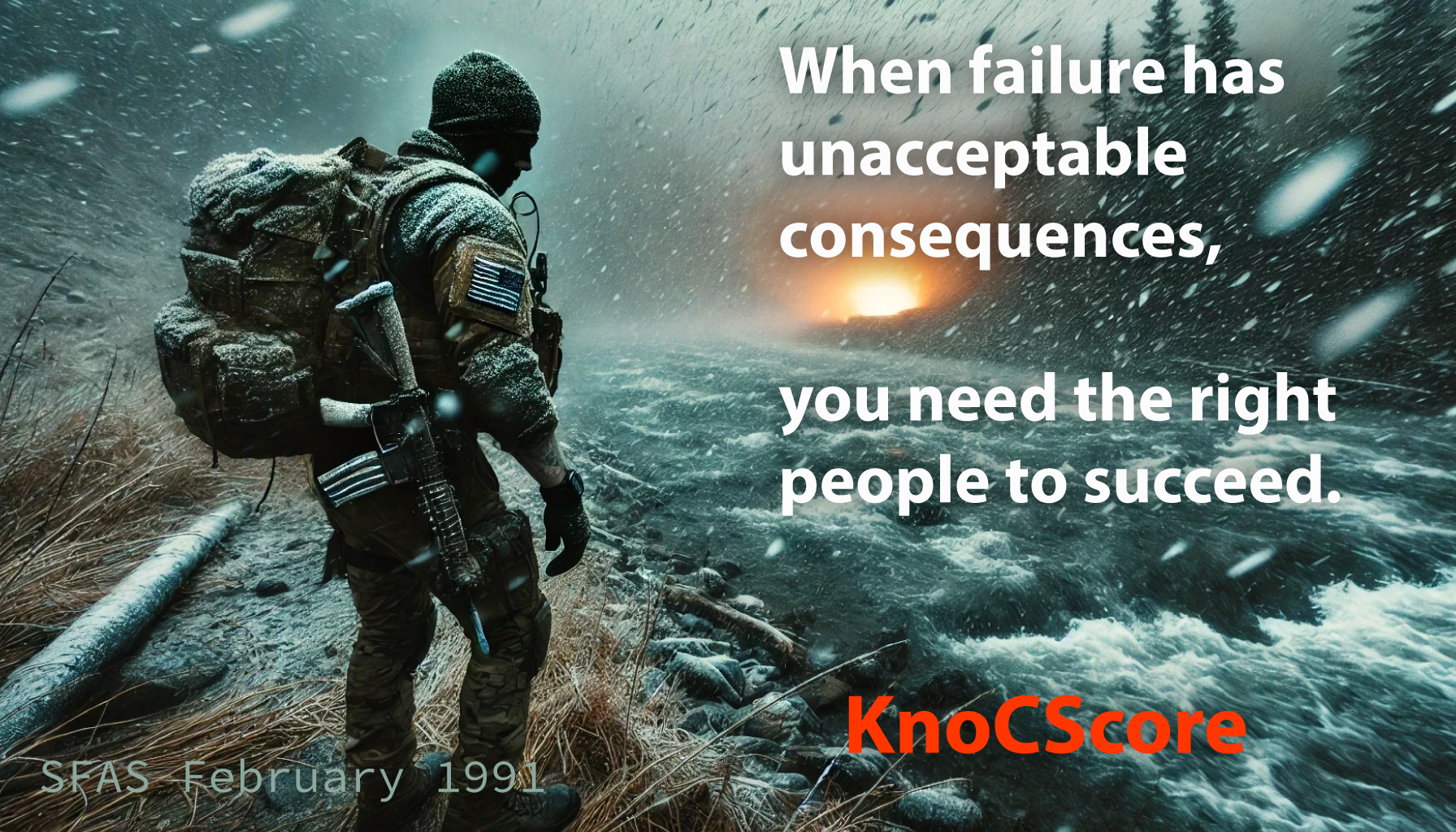KnoCSCore DNA Background story: Special Forces Assessment and Selection Course (SFAS) - February 1991

Read Time: 11 minutes
Introduction
When failure has unacceptable consequences, you need the right people to succeed. From its origins in the OSS during WWII, Special Forces has a long history of selecting individuals that will succeed despite the danger and difficulty of the missions they may be assigned. KnoCSCore derives its roots from these lessons. Written from one of the many stories that are at the heart of KnoCScore.
The Special Forces Assessment and Selection Course (SFAS) serves as the initial gate for candidates aspiring to join the US Army’s elite Special Forces. The course is comprised of three phases, one of which is the rigorous land-navigation phase. In this phase, candidates navigate several days of consecutive challenging courses with 80 to 90 pounds of equipment. Typically, there are two navigation events each day—one during the day and one at night. Each event can range between 6 to 20 kilometers.
Candidates face numerous challenges, including fatigue, stress, sleep deprivation, and physical pain. They must move on foot, alone, without any assistance, across difficult terrain, remaining undetected while reaching several points on a map. Electronic devices, such as GPS, are not allowed; navigation must be done manually by plotting positions on a map. If they are caught using roads or bridges, they are disqualified. Timeliness is crucial, as failing to reach the next point on time results in disqualification, however they are not given a timeline to reach the next point. Instead, they are told to move as fast as they can.
Upon reaching a navigation point, usually hidden in dense thicket, candidates are given one of a few options by the cadre: another point to navigate to, notification of failure, or the instruction to sit by the fire. Candidates who have not finished or quit, then plot their next point, which could be 4 to 10 kilometers away. The endpoint of this phase is never disclosed in advance. The sight of a warm fire, where a few candidates might be resting and eating, tempts candidates who are exhausted from days of harsh conditions. Quitting, however, means forfeiting the chance to join the US Army Special Forces, popularly known as Green Berets.
On a bitter, stormy, and dark winter night in February 1991, the conditions were particularly severe. The temperature hovered just above freezing, with debilitating rain and ice. Soaked and cold, candidates had to chip ice from their clothing. Navigating through forested areas was especially challenging as tree branches and leaves pressed cold, wet water against them, and thorny vines snagged their uniforms and equipment, slowing movement and increasing physical strain. Maps needed protection from water, ice, and the notorious 'wait-a-minute vines'. Often candidates would fight through a thicket to find that their pocket had been ripped off and their map was absconded. Thickets often surrounded the many streams and on this night, those streams were swollen, moving quickly from days of constant rain, and had reached the tops of their banks.
The weather and conditions were unusually harsh even for SFAS, but warfare knows no limits. That night there remained over 140 souls. There was no slight to the many very capable and determined candidates pounding through. With no visibility and short on time, some chose to take short cuts knowing that they would face a water crossing. When faced with the deep flooded streams, there were few options. Crossing a cold deep and fast flowing stream using brute force could end up causing hypothermia, being overpowered by the strength of the current, and drowning. Two chose to improvise by cutting down trees. One of them, when faced with an impossibly large stream, cut down a 20-foot pine tree standing next to the stream using a 4-inch sawblade of a Swiss Army Knife. Upon being returned to the empty barracks, they were the only two who had succeeded that night.
When faced with adversity and limited resources, it’s not about anything else. the most critical factors are an individual’s skills, intelligence, and determination to succeed. These values are essential not only in Special Forces but also in the business world. Having a strong and capable workforce will make the difference between failure and being a great company. KnoCScore’s patent pending methods provides unquestionable credentials, and ambiguates the irrelevant variables to help identify individuals who possess these traits.

Opportunity seldom knocks twice.
Limited early access is closing soon. Securing your spot and being among the first to build your score will give you an important competitive advantage. When you do you'll gain a head-start with a higher score.
Get started now before thousands follow.